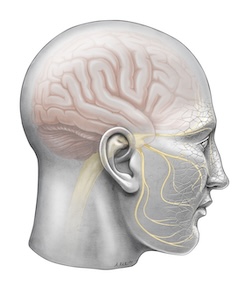Understanding Facial Pain
Facial pain can be severe and debilitating. It’s also important to know:
- Facial pain can have many causes.
- A precise diagnosis is essential to effective treatment.
- There are many types of facial pain.
- Trigeminal neuralgia can cause intense pain.
This page focuses on trigeminal neuralgia, the main type of facial pain we treat at the OHSU Brain Institute. For TMJ (temporomandibular joint) pain, please visit our dental care pages.
What is facial pain?
Facial pain can be sharp or dull, throbbing or achy, constant or sporadic. Trigeminal neuralgia, the main type we treat, involves the trigeminal nerve. It is a long-term condition. Some other types, such as those linked to an injury or infection, often go away after the cause is identified and treated.

Trigeminal nerve: The trigeminal nerve carries sensations from the face to the brain. It has three main branches on each side of the head, with each branch connecting to a region of the face:
- Ophthalmic (eyes)
- Maxillary (upper jaw)
- Mandibular (lower jaw)
The nerve helps control functions such as biting, chewing and swallowing. It’s one of 12 pairs of cranial nerves that connect the brain to the body.
Trigeminal neuralgia: Trigeminal neuralgia occurs most often when a blood vessel presses against the trigeminal nerve, causing piercing pain.
Who gets facial pain?
- Anyone can be affected by facial pain.
- Trigeminal neuralgia is most common in women and in those older than 50.
- Trigeminal neuralgia is rare, with about a dozen new cases per 100,000 people each year.
- OHSU facial pain experts are taking part in an international study of patients with trigeminal neuralgia to identify genetic markers. Markers could indicate those at high risk of developing facial pain, potentially leading to a cure.
What causes facial pain?
The face has many nerves, muscles, bones, teeth, tissues and joints connecting in a tight space. That can make pinpointing a cause difficult. Sometimes no cause can be found.
Common causes include:
- An outbreak of the virus that causes chicken pox, shingles and cold sores
- Injury from an accident or treatment
- TMJ (temporomandibular joint disorder, affecting a jaw joint)
- An abscessed tooth
- Sinus infection
- Migraine or cluster headache
- Chronic muscle pain syndrome
- Mental and emotional issues
Trigeminal neuralgia:
- In about half of cases, this is caused by a blood vessel pressing on (compressing) the trigeminal nerve.
- In the other half of cases, especially in young women, there is no compression and the cause is unknown.
- Multiple sclerosis can cause trigeminal neuralgia by degrading the nerve’s protective sheath.
- Rarely, a tumor or tangle of malformed arteries press on the trigeminal nerve.
Symptoms of trigeminal neuralgia
Stabbing pain: The pain can be so intense that it’s difficult to bear physically and mentally.
Affected areas: Pain occurs in parts of your face connected to branches of the trigeminal nerve. They include your lips, eyes, nose, scalp, forehead and jaw. Trigeminal neuralgia often affects one side but can affect both sides at different times.
Duration: Episodes of pain can occur over days, weeks or months, then disappear for a time. The pain often returns, and it tends to worsen over time. Untreated, trigeminal neuralgia can persist for years. Pain episodes can range from a few seconds or minutes to constant.
Triggers: Contact with your cheek — from shaving, putting on makeup, brushing your teeth, eating or talking — can spark flashes of pain.
Types of trigeminal neuralgia
OHSU’s Dr. Kim Burchiel, an internationally recognized neurosurgeon and the lead doctor at our facial pain clinic, developed this classification system. He saw a need to replace a three-part system that had too much overlap between categories.
The new system, widely followed around the world, helps patients and doctors quickly identify pain so they can zero in on the most effective treatment.
Trigeminal neuralgia Type 1: This type, also called TN1, develops on its own (meaning it’s not caused by an injury). It occurs in episodes more than half the time.
Trigeminal neuralgia Type 2: TN2 develops on its own and is constant more than half the time.
Trigeminal neuropathic pain: This is facial pain from an unintentional nerve injury, such as facial trauma, stroke or surgical complication.
Trigeminal deafferentation pain: This is pain in an otherwise numb area of your face after surgery to try to correct pain by disrupting nerves.
Symptomatic trigeminal neuralgia: This is facial pain in multiple sclerosis patients. It’s caused by deterioration of the trigeminal nerve’s protective coating.
Postherpetic neuralgia: This is pain from an outbreak of herpes zoster, the virus that causes chicken pox and shingles.
Atypical facial pain: This is pain resulting mainly from a mental or emotional issue.
Nervus intermedius neuralgia: This type has recurring attacks of severe pain deep in the ear. It may spread to eye area or other parts of the ear.
Glossopharyngeal neuralgia: This type has recurring attacks of severe pain in the back of the throat, near the tonsils, tongue and ear.
Learn more
- Try our tool for diagnosing facial pain
- Questions and answers about our facial pain tool
- Trigeminal Neuralgia Information Page, National Institute of Neurological Disorders and Stroke
- Facial Pain Association
- TMJ Disorders, National Institute of Dental and Craniofacial Research
For patients
Call 503-494-4314 to:
- Request an appointment
- Seek a second opinion
- Ask questions
Location
Parking is free for patients and their visitors.
Center for Health & Healing Building 1
Neurological Surgery, eighth floor
3303 S. Bond Ave.
Portland, OR 97239
Map and directions
Refer a patient
- Refer your patient to OHSU.
- Call 503-494-4567 to seek provider-to-provider advice.
Facial pain tool
Use our interactive questionnaire to assess the kind of facial pain you have and to learn about treatment options.